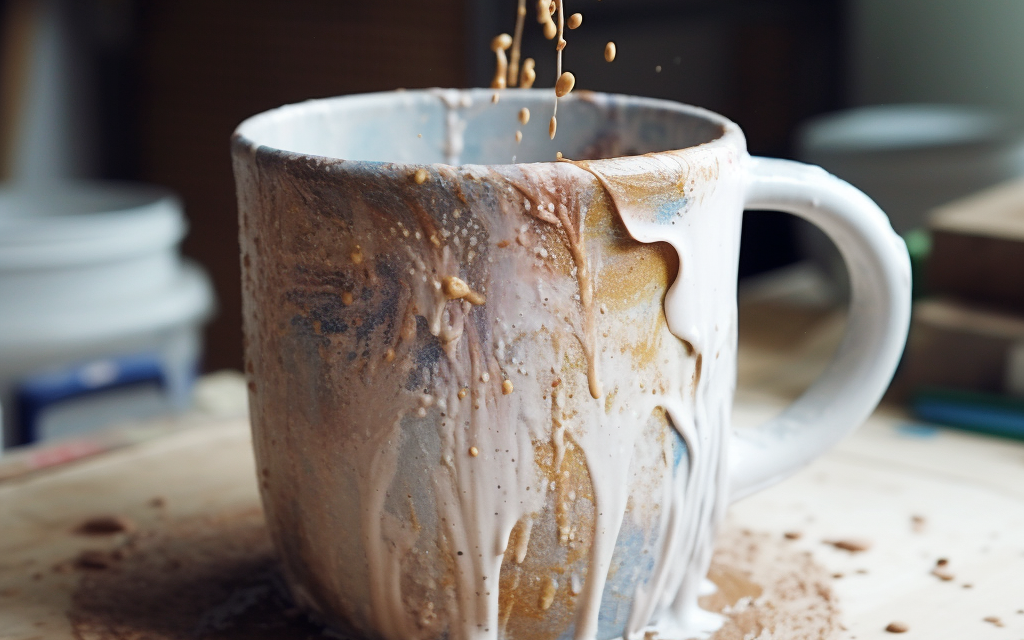As an Amazon Associate, we earn from qualifying purchases. We may also earn commissions if you purchase products from other retailers after clicking on a link from our site.
I can’t imagine starting my day without my favorite ceramic coffee mug. Over time, my mug has become stained and even started to develop a bit of an odor.
After trying several cleaning methods, I’ve finally developed a step-by-step process that works every time. In this article, I’ll share my tips for cleaning your ceramic coffee mug and keeping it in great condition.
1. Gather Your Materials
Before you start cleaning your mug, gather your materials. You will need dish soap, a soft-bristled scrub brush, and a clean towel for drying.
Avoid using abrasive sponges or brushes that can scratch the surface of your mug.
2. Pre-Wash the Mug
Rinse your mug with hot water to remove any loose coffee grounds or residue.
This will make the cleaning process easier and more effective. If you’re dealing with a stubborn stain, let the mug soak in hot water for a few minutes before scrubbing it.
3. Scrub the Inside of the Mug
Apply a small amount of dish soap to your scrub brush and use it to scrub the inside of the mug.
Pay particular attention to any areas where coffee stains may have accumulated, such as the bottom or sides of the mug. If your mug has a narrow opening, use a bottle brush to clean the inside. Rinse the mug thoroughly with hot water.
4. Clean the Outside of the Mug
Using the same scrub brush, apply dish soap to the outside of the mug and scrub it clean.
Pay attention to any areas where your fingers or lips touch the mug, as these can often collect oils and dirt. Rinse the mug thoroughly with hot water.
5. Rinse the Mug Thoroughly
After scrubbing both the inside and outside of the mug, rinse it thoroughly with hot water to remove any soap residue. Rinse the mug thoroughly to prevent any leftover soap from affecting the taste of your coffee.
6. Dry the Mug
Using a clean towel, dry the mug thoroughly. Dry both the inside and outside of the mug to prevent water spots from forming. If you’re in a hurry, let the mug air dry, but turn it upside down to allow any remaining water to drain out.
7. (Optional) Deep Cleaning Methods for Tough Stains
If your mug has tough stains that won’t come out with soap and water, try one of these deep cleaning methods:
- Baking soda: Make a paste with baking soda and water and apply it to the stain. Let it sit for a few minutes, then scrub and rinse. Baking soda is a natural abrasive that can help to loosen stubborn stains.
- Vinegar: Soak the mug in a mixture of equal parts vinegar and water for a few hours, then scrub and rinse. Vinegar is a natural cleaner that can help to remove stains and odors.
- Denture tablets: Fill the mug with warm water and drop in a denture tablet. Let it sit overnight, then rinse and scrub. Denture tablets contain a mixture of citric acid and sodium bicarbonate, which can help to remove stains and odors.
The Kitchn tested a few different methods, such as vinegar and baking soda, and found that baking soda worked best. I have tried vinegar a few times, and it does work, but you have to let it soak in hot water for a long time. Why bother when baking soda has instant results?
You can see how well baking soda works in the following video:
Tips for Maintaining Your Ceramic Coffee Mug
To keep your ceramic coffee mug in good condition, try these tips:
- Rinse your mug with hot water after each use to prevent stains from setting in. If you’re not able to wash your mug right away, fill it with water to prevent the coffee from drying and staining.
- Avoid using abrasive sponges or cleaning products that can scratch the surface of your mug. Opt for soft-bristled brushes or sponges instead.
- Store your mug in a dry place to prevent odors from developing. Avoid leaving your mug in the sink or near other damp Use your mug only for coffee. Avoid using it to hold other liquids, such as tea or soup, as the residue from these liquids can stain your mug and affect the taste of your coffee.
- Consider investing in a separate mug for tea or other beverages to prevent cross-contamination and maintain the quality of your coffee. Moreover, I found that black tea leaves a nasty residue that needs thorough scrubbing to remove.
Once your ceramic coffee mugs are clean, it’s important to learn how to take care of them. You can learn how to do that by reading 10 Tips for Caring for Your Ceramic Coffee Mug.
Are Ceramic Coffee Mugs Dishwasher Safe?
Most ceramic coffee mugs are dishwasher-safe as long as they are not too delicate or have any metal parts. However, some ceramic mugs may fade, crack, or chip over time due to the high temperature and pressure of the dishwasher cycle.
To prevent damage to your ceramic mugs, it’s recommended to hand-wash them with mild dish soap and warm water. This will help avoid any harsh chemicals and high temperatures that can potentially damage the glaze or paint on the mug.
If you prefer to use a dishwasher, you can try using the gentle or delicate setting, which uses lower temperature and pressure to clean the dishes. Additionally, it’s a good practice to place your ceramic mugs on the top rack of the dishwasher and avoid stacking them too close together to prevent any potential collisions that can cause chips or cracks.
It is also important to note that some ceramic mugs may have metallic elements such as gold or silver accents or rims, which can discolor or become damaged in the dishwasher. For these types of mugs, I only hand-wash them with mild soap and water and avoid exposing my cups to harsh chemicals or abrasive sponges.
Overall, while most ceramic mugs are dishwasher-safe, it’s important to read the manufacturer’s instructions or test a small area first to ensure they are compatible with your dishwasher.
Taking proper care of your ceramic mugs can help prolong their lifespan and preserve their appearance for many years to come.
They’re also a great choice for cafés.

Can You Put a Scratched Mug in the Dishwasher?
As mentioned above, scratched ceramic coffee mugs are not safe to drink from, so you should not put them in the dishwasher either.
The dishwasher can worsen the damage and cause more cracks or chips that can expose more clay or metal to your drink. Moreover, the dishwasher can also contaminate other dishes with harmful substances that may leach from the scratched mug.
If you have a scratched mug that you want to keep for sentimental reasons, you can either repair it using food-safe epoxy glue or ceramic paint or use it for non-food purposes such as holding pens or plants.
I’ve repurposed a few of my old Le Creuset mugs for all kinds of things. They give my house that homey, rustic look without shelling out a single dime.
Final Thoughts
Cleaning my ceramic coffee mug is an essential part of my morning routine. With these tips and tricks, I can keep my mug in great condition and enjoy a delicious cup of coffee every day.
By following these steps and maintaining your mug properly, you can enjoy your favorite coffee without any stains or odors.








